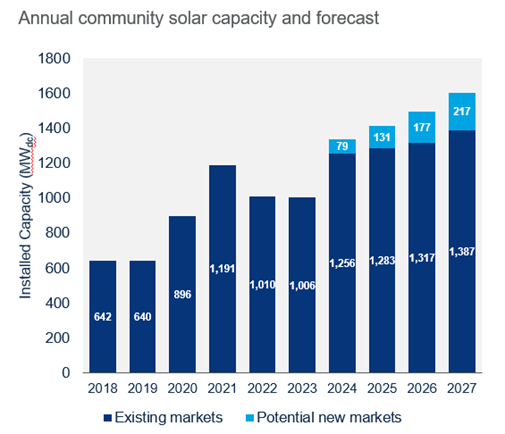Get in touch
-
Mark Thomtonmark.thomton@woodmac.com
+1 630 881 6885 -
Hla Myat Monhla.myatmon@woodmac.com
+65 8533 8860 -
Chris Bobachris.boba@woodmac.com
+44 7408 841129 -
Angélica Juárezangelica.juarez@woodmac.com
+5256 4171 1980 -
BIG PartnershipWoodMac@BigPartnership.co.uk
UK-based PR agency
US community solar growth slowed 16% in 2022; national market expected to double by 2027
New and potential markets to boost five-year outlook pending market and policy reforms
2 minute read
US community solar installed capacity declined 16% in 2022 compared to last year, primarily driven by interconnection delays hindering growth in key state markets such as Massachusetts, Maine, and Maryland. Industry-wide supply chain constraints also pushed project timelines into 2023, according to the latest report released by Wood Mackenzie in collaboration with the Coalition for Community Solar Access (CCSA).
Despite the short-term market contraction in 2022, Wood Mackenzie forecasts the US community solar market to grow 118% over the next five years, with at least 6-gigawatts direct current (GWdc) of community solar capacity expected to come online in existing markets between 2023 – 2027. New York, which currently holds 49% of the national market, installed around 500-megawatts direct current (MWdc) in 2022. Current total installed capacity for 2022 is estimated to be 5.27 GWdc.
CCSA’s new target of 30 gigawatts (GW) of community solar by 2030, announced in January 2023, will require an acceleration of installed capacity in existing markets and continued establishment of new state markets. Wood Mackenzie’s current forecasts, based on existing markets and a conservative forecast of new market opportunities, show that 11.5 GWdc of community solar is expected to be installed by 2027.
“Any upside to our existing forecast will require strong policy and market reforms that release pipeline backlogs in existing markets, as well as additional capacity from new state markets. The newly passed state-wide program in California, for example, has the potential to yield a significant number of megawatts in the coming years,” Caitlin Connelly, research analyst at Wood Mackenzie, said.

Source: Wood Mackenzie's US Distributed Solar service
“The Inflation Reduction Act (IRA) is cause for optimism. Community solar developers are well-positioned to take advantage of the new and extended investment tax credits (ITC) once guidance is released in 2023, with many developers interested in qualifying projects for the low-to-moderate income (LMI) and domestic content adders,” Connelly said.
Connelly continued: “These adders—as well as other incentive programs like the greenhouse gas reduction fund will support growth in existing markets and create momentum for the creation of new state markets, which Wood Mackenzie and the CCSA continue to monitor closely.”
"To meet policymakers' economic, social, and environmental goals, state legislatures and regulators must move community solar projects swiftly through interconnection queues and remove red tape to get as much capacity installed as possible," said Jeff Cramer, CEO of the Coalition for Community Solar Access. "Doing so will move us closer to what we all want — jobs, economic development, and a decarbonized, cost-effective grid that works for all of us."
If program proposals are enacted, new state markets will provide upside to the national forecast starting in 2024. Wood Mackenzie’s preliminary forecasts (which are inherently conservative) project a 605 MWdc boost by 2027 from potential new state markets including Michigan, Ohio, Wisconsin, Pennsylvania, and Washington.

Source: Wood Mackenzie's US Distributed Solar service
The report also found that as project portfolios grow, community solar developers are increasingly outsourcing subscriber acquisition and management services to third-party companies. The top three subscriber companies now manage over 37% of the total market.
“The landscape for subscriber companies is becoming more competitive and complex. Developers seek partners that can successfully subscribe projects, form trusting relationships with subscribers, and manage these relationships throughout the lifetime of the project or program,” Connelly said.
The top three community solar developers secured 16.5% of the total market between 2017 – 2022, but competition remains stiff for newcomers.






